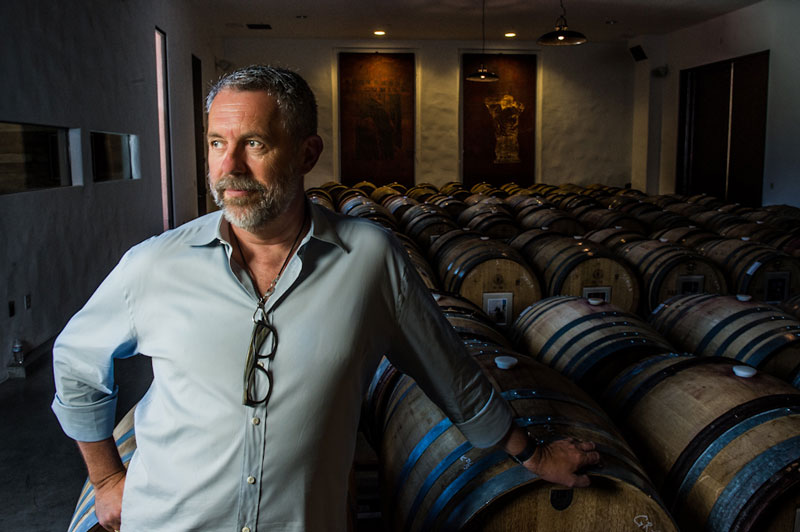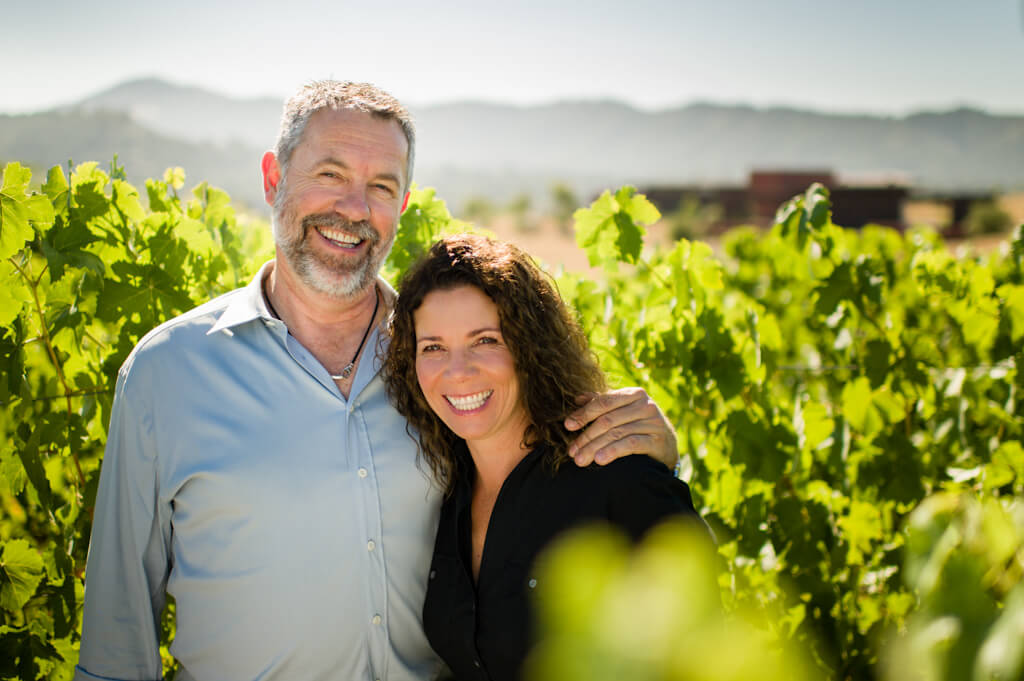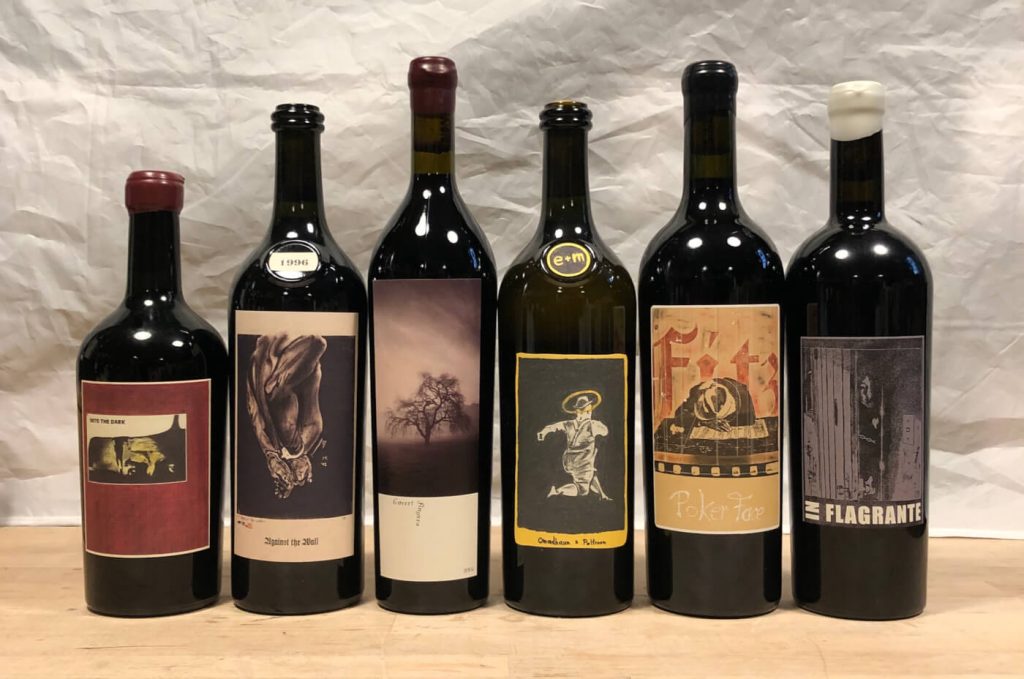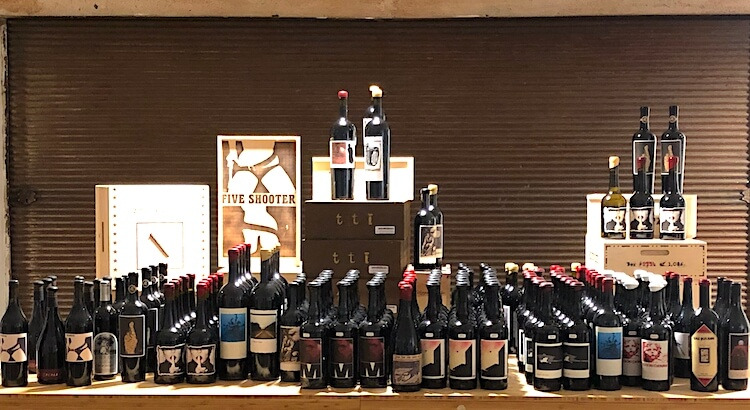In the ever-evolving landscape of California wine, there exists a handful of producers who have transcended the boundaries of simple winemaking to become cultural icons, and among them, none shine brighter than Sine Qua Non, a winery whose very name suggests something indispensable, a creation that cannot be overlooked or imitated. The story of Sine Qua Non is as much about artistry, vision, and perseverance as it is about grapes and terroir, for the Krankl family, who built this estate from the ground up, have always viewed wine as an act of self-expression rather than mere agriculture or commerce.
The roots of this journey stretch back to the early 1990s in Los Angeles, a city more readily associated with Hollywood glamour than the vineyards of the Central Coast. Manfred Krankl, an Austrian emigre with a background in the culinary world, co-founded the acclaimed restaurant Campanile, where he honed his appreciation for food, wine, and the nuances of hospitality. It was here, in a city buzzing with creativity, that his own curiosity for winemaking took form. In 1994, Krankl crafted a small batch of Syrah—just four and a half barrels, scarcely enough to fill a corner of a cellar—and gave it the audacious name “Queen of Spades.” This wine, though limited in quantity, carried a profound sense of individuality, a departure from the polished sameness of many Californian wines of that era. When Robert Parker tasted it and awarded it 95 points, Sine Qua Non was catapulted into the limelight, instantly gaining a reputation as a daring new voice in American wine. What began as a humble experiment quickly transformed into a cult phenomenon, attracting a fiercely loyal following of collectors and sommeliers who recognized that something genuinely new had arrived.
As the years unfolded, the Krankls made a conscious choice to embrace unpredictability, to eschew tradition, and to refuse repetition. Every vintage carried a new name and a new visual identity, with Manfred himself designing the artwork for each label, often employing his own linocut prints or paintings. The bottles were sculptural and unconventional, some tall and thin, others squat and broad, as if each wine demanded its own physical form. This sense of continual reinvention, where no wine was ever quite like the last, elevated Sine Qua Non from a winery into an ongoing creative project, a marriage of fine art and viticulture. In more recent times, when regulatory complexities made it difficult to approve endlessly changing names, the Krankls introduced the “Distenta” series, which provided continuity while still allowing for the playful mystery that had always been part of the brand’s allure.

Sine Qua Non
1750 Tierra Rejada Road | Simi Valley, CA 93065 | USA
+1 (805) 640-1801 | Fax: +1 (805) 640-1802
Email | Website
Instagram | LinkedIn
Winemaking: Rhone Roots, Uncompromising Craft
The soul of Sine Qua Non lies in its devotion to Rhone varietals, but unlike many producers who emulate the Rhone Valley with faithful precision, the Krankls approach these grapes with an artist’s sense of interpretation. Syrah, Grenache, and Mourvedre form the structural backbone of their red wines, providing a combination of richness, spice, and longevity, while the whites are often blends of Roussanne, Marsanne, and Viognier, varietals known for their textural complexity and aromatic depth. Yet the Krankls have never been content with the expected. Over the years, they have planted and incorporated lesser-known grapes such as Petit Manseng, Petite Sirah, Graciano, and Touriga Nacional, allowing them to craft blends that carry both familiarity and surprise. This sense of exploration ensures that no two vintages taste the same, and that each release becomes a reflection of both the year and the Krankls’ restless imagination.

In the cellar, the process is guided less by formula than by intuition and taste. Fermentations often rely on native yeasts, which carry the fingerprint of each vineyard site and vintage. The ageing process is equally unorthodox, with wines spending time in an array of vessels ranging from new French oak barriques to large casks and sometimes neutral containers, depending on the expression desired. Certain cuvées undergo extraordinarily long ageing, particularly the Extended Barrel Age (EBA) wines, which may rest for up to five or six years before bottling, a practice rare in California and reminiscent of old European traditions. The wines are usually bottled unfined and unfiltered, ensuring that every nuance of aroma, flavor, and texture remains intact. The result is a portfolio of wines that are as distinctive in the glass as they are in the bottle, each one an original creation that pushes the boundaries of Californian winemaking.

The People Behind the Legend
At the center of Sine Qua Non is the dynamic partnership of Manfred and Elaine Krankl. Manfred, with his background in art and design, brings an irrepressible energy and a commitment to individuality, ensuring that each wine is not only a beverage but also an expression of personality and creativity. Elaine provides the balance and discipline necessary to translate Manfred’s vision into reality, anchoring the winery with her practical leadership and quiet determination. Their collaboration is seamless and enduring, embodying the sense that Sine Qua Non is not simply a business venture but rather the life’s work of a couple whose passions are deeply intertwined.
Unlike larger wineries that depend on extensive teams of enologists, marketers, and vineyard managers, Sine Qua Non remains strikingly personal. Every decision, from vineyard planting densities to the final artwork on a label, carries the Krankls’ imprint. While additional hands assist in the farming and winemaking, the intimacy of the project is never lost. This sense of human scale, combined with the limited production of just a few thousand cases per year, amplifies the perception that each bottle carries not just the essence of place but also the soul of its creators.
Vineyards & Terroir
The vineyards that supply Sine Qua Non are as distinctive as the wines themselves, each offering a unique expression of California’s diverse geography. For many years, the Krankls sourced fruit from top growers such as Bien Nacido Vineyard in Santa Maria, a site renowned for Syrah of elegance and depth. Yet in time, they sought greater autonomy and began acquiring their own land, culminating in the ownership of four estate vineyards, each with its own personality and microclimate.
The Eleven Confessions Vineyard, located in the Santa Rita Hills, is one of the crown jewels of the estate. Here, cold ocean winds sweep through the vines, delaying ripening and allowing grapes to develop remarkable complexity. Harvests are often among the latest in California, with dense plantings and extremely low yields ensuring that every cluster delivers profound concentration.
The Cumulus Vineyard, encircling the Krankls’ home in Oak View, provides a striking contrast. Warmer and sunnier, it allows for a diverse range of plantings, including Syrah, Grenache, Roussanne, Petite Sirah, Petit Manseng, and Touriga Nacional. These vines are planted densely and, in many cases, on their own roots, a choice that reflects the Krankls’ desire to mirror the intensity and individuality of old-world vineyards.
The Third Twin Vineyard, near Los Alamos, is defined by sandy soils that naturally resist phylloxera. This site is devoted largely to Syrah and Petite Sirah, producing wines with a distinctive backbone of tannin and aromatic lift, lending balance and poise to blends that might otherwise be dominated by power.
The Molly Aïda Vineyard, high in Tepusquet Canyon, is a remote and dramatic site where Mourvèdre thrives under head-trained vines. Its elevated position and rugged isolation yield grapes of haunting perfume and savory complexity, lending a distinctive character to the estate’s wines.
Though the Krankls rarely make public statements about organic certification, their farming is practiced with the utmost respect for the environment, avoiding shortcuts and focusing on long-term soil vitality. The result is fruit that reflects the health of its environment, wines that are pure, transparent, and profoundly expressive of their origins.
A Sommelier’s Conclusion: The Essence of SQN
To assess Sine Qua Non from the perspective of a sommelier is to encounter a body of work that defies easy categorization. These wines are not merely Rhône varietals transplanted into California soil; they are statements of individuality, originality, and artistry. They combine the density and power of California fruit with the elegance and nuance of European tradition, yet they are neither Californian imitations of the Rhône nor Rhône wines in disguise. They are wholly themselves, unmistakably unique.
In the glass, one discovers layers of black fruit, violet, spice, smoke, and mineral undertones, with whites that move from honeyed stone fruit to exotic florals, always carried by remarkable texture and balance. The longevity of the wines is equally impressive; the reds, particularly those dominated by Syrah, evolve for decades, while the whites display surprising endurance well beyond the norm for California. For collectors, sommeliers, and wine professionals alike, Sine Qua Non is not simply a conversation piece—it is a lesson in how creativity, risk, and fidelity to one’s vision can redefine an entire category of wine.
Ultimately, Sine Qua Non lives up to its name by being indispensable not because of scarcity alone, but because it demonstrates that wine, at its most profound, can transcend tradition and function as both art and sustenance. It is this duality—wine as both nourishment and expression—that makes the Krankls’ work one of the most compelling stories in contemporary wine, and ensures that every bottle is eagerly anticipated, lovingly cellared, and reverently poured.

The Catalogue of Sine Qua Non Wines
Since its founding in 1994, Sine Qua Non has released a dazzling array of wines, each bearing a distinctive name and label, with no two vintages alike until the recent Distenta series. This catalogue traces their creative output, from the early Syrah bottlings that captured collectors’ imaginations to the modern estate-grown cuvées.
The Early Years (1994–1999)
The story begins with the 1994 Syrah Queen of Spades, the wine that effectively launched the Sine Qua Non legend. It was followed by a string of evocatively named bottlings: The Bride (1995), The Marauder (1997), Against the Wall (1998), and The Other Hand (1999). These early wines were largely Syrah-based, often blended with small amounts of Grenache or Mourvèdre, setting the Rhône-inspired signature that remains central to the estate today. Production in this period was tiny, rarely exceeding a few hundred cases, and the wines were allocated almost exclusively to mailing list members.
Establishing the Cult (2000–2009)
By the turn of the millennium, Sine Qua Non had become the epitome of California’s Rhône renaissance. Names became more elaborate, with releases such as In Flagrante (2000), Just for the Love of It (2002), and The Naked Truth (2004). During this decade, Krankl also began to experiment with Grenache-driven reds like The Inaugural (2003), while whites such as Twisted & Bent (1997), Boots, Pasties, Scanty Panties (2000), and The Petition (2002) introduced collectors to Marsanne, Roussanne, and Viognier blends that rivaled the Northern Rhone.
It was also in the 2000s that the winery began releasing its Extended Barrel Age (EBA) wines, rare bottlings that spent four to six years in oak before bottling. Among the most famous were The 17th Nail in My Cranium (2005 Syrah EBA) and The Inaugural Grenache EBA (2003). These wines, often released in minuscule volumes, cemented Sine Qua Non’s reputation as a cult producer.
Expansion and Refinement (2010–2019)
The next decade saw the vineyard holdings expand, particularly with the Eleven Confessions Estate in the Santa Rita Hills, allowing for greater control over fruit sources. Wines like Five Shooter (2010), Trouver l’Arène (2012), Le Chemin Vers l’Hérésie (2013), and Rätsel 16 (2016) reflected the increasingly sophisticated blends of Syrah and Grenache, while whites such as The Monkey (2011) and Lightmotif (2014) showcased the full potential of Rhône whites grown under California’s sun.
This era also saw whimsical bottlings like The Writing on the Wall (2014) and The Third Twin collaborations, where Krankl worked with Manfred’s close friend John Alban to create micro-releases from neighboring vineyards. Production remained small, usually between 600 and 2,000 cases, with labels and names changing each year.
The Modern Era (2020–Present)
Since 2021, Sine Qua Non has streamlined its naming convention with the Distenta series. Rather than inventing a completely new title every year, Krankl created a framework of Distenta I, II, III, and so on, while still varying the blends and labels. These wines, available as both red and white cuvées, are entirely estate-grown, representing the full maturity of Sine Qua Non’s vineyard vision. For collectors, they offer a thread of continuity without losing the element of surprise.
Alongside Distenta, micro-releases and EBAs continue to appear, ensuring that each allocation cycle retains its sense of exclusivity and excitement.
Whites, Rosés, and Rarities
While Syrah and Grenache are the backbone, Sine Qua Non has always played with whites and, occasionally, roses. Standouts include On the Lam (2006), a Grenache Blanc and Roussanne blend, The Hoodoo Man (2010), based on Roussanne, and Patine (2011), a Viognier-led wine with astonishing texture. Roses, such as And an Eight Track (2002), have been made in tiny quantities and are rarely seen outside the most loyal mailing list circles.
The Catalogue in Perspective
Across three decades, Sine Qua Non has produced well over one hundred distinct bottlings, each bearing a singular name, artwork, and identity. No other winery in California, or indeed the world, has pursued such a radical departure from traditional branding. Instead of building a single flagship, Krankl has built an entire mythology, with every release becoming a collectible artifact as much as a wine.
1994
Queen of Spades – Syrah (first release, ~100 cases)
1995
The Bride – White blend (Chardonnay & Viognier)
Queen of Hearts – Rosé (Grenache-based, ~150 cases, never re-released)
The Other Hand – Syrah
Red Handed – Red blend
1996
Omadhaun & Poltroon – Syrah
E–Lips – White blend
Left Field – Red blend
Against the Wall – Syrah
1997
Twisted & Bent – White blend
Crossed – Rosé
The Complicator – Syrah
Imposter McCoy – Red blend
1998
Backward & Forward – White blend
El Corazón – Rosé
Veiled – Syrah
The Antagonists – Syrah
E–Raised – Red blend
1999
Tarantella – White blend
XL – Syrah
The Ox – Syrah
Icarus – Syrah
The Marauder – Red blend
2000
The Boot – White blend
The Hussy – Chardonnay (rare single varietal)
The Filly – Rosé
A Capella – Syrah
Incognito – Syrah
Heels Over Head – Syrah
In Flagrante – Red blend
Suey – Syrah
2001
Albino – White blend
Rien Ne Va Plus – White blend
Pagan Poetry – Rosé
No. 6 – Syrah
Midnight Oil – Syrah
On Your Toes – Syrah
Ventriloquist – Syrah
Inamorata – Red blend
2002
Whisperin’ E – White blend
E° – Syrah
Hollerin’ M – Syrah
More Than a Number – Red blend
Heart Chorea – Syrah
Just for the Love of It – Syrah
2003
Sublime Isolation – White blend
Omega – Syrah
Li’l E – Syrah
Papa – Syrah
The Inaugural (Eleven Confessions) – Syrah (EBA, ~250 cases, first estate bottling)
Boots, Pasties, Scanty Panties – White
Trockenbeerenauslese – Dessert wine
2004
The Rejuvenators – White blend
Covert Fingers – Syrah
Into the Dark – Syrah
Ode to E – Syrah
Poker Face – Syrah
2005
The Petition – White blend
Strapless – Rosé
Over & Out – Syrah
Atlantis – Grenache
The Naked Truth – Syrah
The 17th Nail in My Cranium – Syrah
2006
The Hoodoo Man – White blend
Autrement Dit – Rosé
In The Crosshairs – Syrah
The Raven – Syrah
A Shot in the Dark – Syrah
To The Rescue – Grenache
2007
Body & Soul – White blend
Stripes & Stars – Rosé
Pictures (Grenache) – Grenache blend
Pictures (Syrah) – Syrah blend
Labels – Syrah blend
Dangerous Birds – Syrah blend
2008
Kolibri – White blend
Jinete Bajo – Rosé
The Pontiff – Syrah
The Duel – Syrah
The Line – Grenache
B20 – Syrah
2009
On The Lam – White blend
Packin’ Rosy – Rosé
Upside Down – Grenache
The Thrill of Stamp Collecting – Syrah
Esto No Es Una Salida (This Is Not an Exit) – Syrah
2010
The Monkey (That Type) – White blend
Of Rosay – Rosé
Stockholm Syndrome – Grenache (EBA, very rare)
Five Shooter – Syrah
2011
The Moment – White blend
Dark Blossom – Rosé
Patine – Syrah
2012
In the Abstract – White blend
Pearl Clutcher – Rosé
Stein – White
Stock – Syrah
The Writing on the Wall – Grenache
Shackled – Syrah
Touché – Syrah
2013
…And an Eight Track – White blend
Résisté – Rosé
Male – Syrah
Female – Grenache
Jusqu’à l’os – Syrah
Le Supplement – Grenache
2014
Gallinita – White blend
Lightmotif – Rosé
Piranha Waterdance – Syrah
Shakti – Grenache
Capo Dei Putti – Syrah
Testa Dei Cherubini – Grenache
2015
Entre Chien et Loup – White blend
Le Chemin Vers L’Hérésie – Syrah
Trouver L’arène – Grenache
M – Syrah
E – Grenache
2016
Deux Grenouilles – White blend
Dirt Vernacular – Grenache
Rätsel 16 – Syrah
Subir – Syrah
Pajarito del Amor – Grenache
2017
Tectumque – White blend
The Hated Hunter – Syrah
The Gorgeous Victim – Grenache
Eleven Confessions – Syrah & Grenache (EBA bottlings)
2018
Profuga – White blend
Ziehharmonika – Grenache
Aperta – Syrah
Eleven Confessions – Grenache & Syrah (EBA)
2019
Distenta I White – Estate white blend
Distenta I Grenache – Estate Grenache blend
Distenta I Syrah – Estate Syrah blend
2020
Distenta II White – Estate white blend
Distenta II Grenache – Estate Grenache blend
Distenta II Syrah – Estate Syrah blend
📌 Notes on production:
Most cuvées: 600–2,000 cases.
EBA wines (e.g., Eleven Confessions, Stockholm Syndrome, The Inaugural): 200–400 cases, sometimes fewer.
Annual total production across all labels: ~3,500 cases.